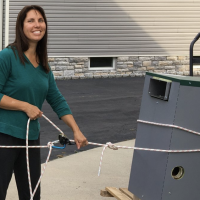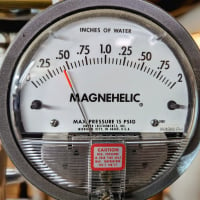Learning from the 1930s

Learning from the 1930s
In this episode, Dan Holohan takes us back to the 1930s when half of the buildings in the U.S. that had central heating had hydronics.
Comments
-
Great article! I grew up in a house and apartments in New Jersey and can remember the faint whistle of the radiator vents on our coal fired steam system. Can even remember early morning as kid feeding 2 shovels, shaking clinkers and cutting back damper on those frigid mornings. We now have a primary secondary hot water system with old CI radiators and love the heat. We have lived in GFA systems throughout life and nothing as comfortable as steam or hydronic heat! Nor as beautiful! Thanks for the sttories and education !
1 -
Thank you for that tale… got me thinking about my own great grandfather and great grandmother (who I overlapped with enough to be able to say I at least sort of knew them) and their reaction to the Great Depression… basically they took the last of their money and put it into Cedric's home here (the system Cedric powers was installed in 1930) to try to save it for future generations… and here we are; my grand daughters are now the eighth generation here. We're not rich in money, but we have a home and that's beyond price.
Br. Jamie, osb
Building superintendent/caretaker, 7200 sq. ft. historic house museum with dependencies in New England4 -
-
People might not like look of high mounted radiators but result is more radiant as opposed to convection. If that is how one likes it then inside wall mounting is preferred.
Concerning cost of steam compared to hot water; doesn't that depend on how many stories building is?
0 -
I like seeing those Ol' copper fittings with the hole in the socket. Mad Dog
0 -
there are certainly wwii training films that show flux. i think they were using resin flux to solder copper. I think borax flux for forge welding goes back centuries.
0 -
Surprised that nobody has opinions about my comment that »Concerning cost of steam compared to hot water; doesn't that depend on how many stories building is?«
On old two or three storey homes the boiler is located near chimney. So for HHW pipes can have one set of verticals and then runouts to radiators. For steam it's usually mains and multiple verticals. Which was cheaper? Recently saw a youtube with steam pipe running under floor. Was that a HHW converted to steam?
0 -
-
Hot water is cheaper to run than steam. smaller piping=less heat loss from the pipe. You don't have to boil the water which increases the efficiency. Steam you have to get to 212 degrees=more stack loss and boiler jacket loss and a larger PU factor. HW you can heat with a low water temp. Maybe as low as 120-130 if designed properly. Lower for radiant.
The lower the temp you run the less fuel you will use.
3 -
Hot water can be made more efficient that steam — but only if you can get the return water temperatures down into the condensing range. That's what makes mod/cons attractive.
Br. Jamie, osb
Building superintendent/caretaker, 7200 sq. ft. historic house museum with dependencies in New England0 -
There is a large contingent that makes the assumption that a mod-con is superior to a fixed output boiler strictly due to the fact that it will condense at suitably low temperatures.
What is normally forgotten in this assumption is the "mod" part of the mod-con. Modulating the firing rate is also a serious variable that gives the mod-con significantly better efficiency.
The contingent compares the fixed output boiler at 85% efficiency to a mod-con that will condense at 93% efficiency. The different is 7%. However, every contractor who installs a mod-con and removes a fixed output boiler finds the increase in efficiency is a minimum of 20% and sometimes as much as 35%.
You either condemn every old boiler that is being replaced as having an efficiency of not more than 65% because nobody serviced it in 20 years or you must reflect on the fact that the improved efficiency of the mod-con has as much to do with the "mod" as it does with the "con".
2 -
There are both gravity hot water systems and low pressure steam home heating systems that are over one hundred years old that still work well and are controlled with low voltage thermostats and or by simply rotating the radiator vents upside down.
It would be fun to find out if the radiators in the Empire State Building still use simple steam vents or TRV's with the low pressure steam their boilers produce to heat the entire skyscraper.
0 -
-
And it may have NYC steam brought in.
It would be very interesting to see how the entire system works.
0 -
-
Far less pounds of H2O have to be transported for steam heat. So I'm not certain that steam heat can't be built to be more efficient than hot water.
0 -
you aren't lifting the water in a hot water system, you are just overcoming the friction losses of the pipe and that energy doesn't evaporate, it is added to the water and pipe.
0 -
LLRCBJ..and the cost of annual service & maintenance on a Mod Con which can eat up the energy savings piggy bank Mad Dog
2 -
I removed a few of these when I gutted my bathrooms.
Heat pumps are probably all the proof you need that steam can technically be made extremely efficient. Perhaps heatpipes would be a closer example, but both use phase change. Add a wicking material like heat pipes into the system and you can even make condensate go uphill.
No, 120+ year old steam systems aren't, but a modern equivalent running in a vacuum @ 100-120F sure could be.
Single pipe 392sqft system with an EG-40 rated for 325sqft and it's silent and balanced at all times.
0 -
@ChrisJ ha it up there. The most efficient possible systems are variations phase change systems in general and heat pumps in particular. Steam heat is one such, but rather obviously heat pumps (and the related refrigerators and air conditioners) are another. The big trick with any of these is the choice of refrigerant, which determines the feasible relationship between the temperature of the hot deck and the temperature of the cold deck and the related pressures.
Br. Jamie, osb
Building superintendent/caretaker, 7200 sq. ft. historic house museum with dependencies in New England0
Categories
- All Categories
- 87.3K THE MAIN WALL
- 3.2K A-C, Heat Pumps & Refrigeration
- 61 Biomass
- 427 Carbon Monoxide Awareness
- 119 Chimneys & Flues
- 2.1K Domestic Hot Water
- 5.8K Gas Heating
- 115 Geothermal
- 165 Indoor-Air Quality
- 3.7K Oil Heating
- 76 Pipe Deterioration
- 1K Plumbing
- 6.5K Radiant Heating
- 395 Solar
- 15.6K Strictly Steam
- 3.4K Thermostats and Controls
- 56 Water Quality
- 51 Industry Classes
- 50 Job Opportunities
- 18 Recall Announcements





